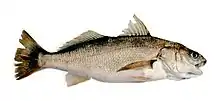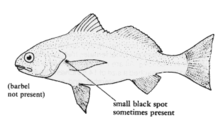White croaker
White croaker (Genyonemus lineatus) is a species of croaker occurring in the Eastern Pacific. White croakers have been taken from Magdalena Bay, Baja California, to Vancouver Island, British Columbia, but are not abundant north of San Francisco. White croakers swim in loose schools at or near the bottom of sandy areas. Sometimes they aggregate in the surf zone or in shallow bays and lagoons. Most of the time they are found in offshore areas at depths of 3 to 30 meters (10 to 100 ft). On rare occasions they are fairly abundant at depths as great as 200 meters (660 feet).
| White croaker | |
|---|---|
 | |
| Scientific classification | |
| Kingdom: | |
| Phylum: | |
| Class: | |
| Order: | |
| Family: | |
| Genus: | Genyonemus Gill, 1861 |
| Species: | G. lineatus |
| Binomial name | |
| Genyonemus lineatus (Ayres, 1855) | |
The white croaker is the only species of in the genus Genyonemus. Other common names for the fish include Pasadena trout, tommy croaker, and little bass.
Description

The body of the white croaker is elongate and somewhat compressed. The head is oblong and bluntly rounded, with a mouth that is somewhat underneath the head. The color is incandescent brownish to yellowish on the back becoming silvery below. The fins are yellow to white. The white croaker is one of five California croakers that have mouths located under their heads (subterminal). They can be distinguished from the California corbina and yellowfin croaker by the absence of a single fleshy projection, or barbel, at the tip of the lower jaw. The 12 to 15 spines in the first dorsal fin serve to distinguish white croakers from all the other croakers with sub-terminal mouths, since none of these has more than 11 spines in this fin.
White croakers eat a variety of fishes, squid, shrimp, octopus, worms, small crabs, clams and other items, either living or dead. While the ages of white croakers have not been determined conclusively, it is thought that some live as long as 15 or more years. Some spawn for the first time when they are between 2 and 3 years old. At this age they are only 12 to 15 cm (4.7 to 5.9 in) long and weigh less than 45 grams (0.099 pounds). Also have barbels on the lower lip. The largest recorded specimen was 41.4 cm (16.3 in), no weight recorded; however, a 36.8 cm (14.5 in) white croaker weighed 640 grams (1 lb 6½ oz).
Fishing information
These fish can be caught on almost any kind of animal bait that is fished from piers or jetties in sandy or sandy mud areas. In fact, they are so easily hooked that most anglers consider them a nuisance of the worst sort. If a person desires to fish specifically for white croakers a tough, difficult-to-steal bait, such as squid, is recommended. When hooked, they put up little or no fight. Fishing and catching is good throughout the year.
Cuisine
White croaker meat has been used as a co-ingredient in creating Crab stick.
References
- Chao, L. & Espinosa Pérez, H. (2020). "Genyonemus lineatus". IUCN Red List of Threatened Species. 2020: e.T154755A130937337. Retrieved 17 July 2020.CS1 maint: multiple names: authors list (link)
- Much of this article is copied from California Marine Sportfish by the California Department of Fish and Game, Marine Region; a public domain resource.
- Froese, Rainer and Pauly, Daniel, eds. (2006). "Genyonemus lineatus" in FishBase. 5 2006 version.
